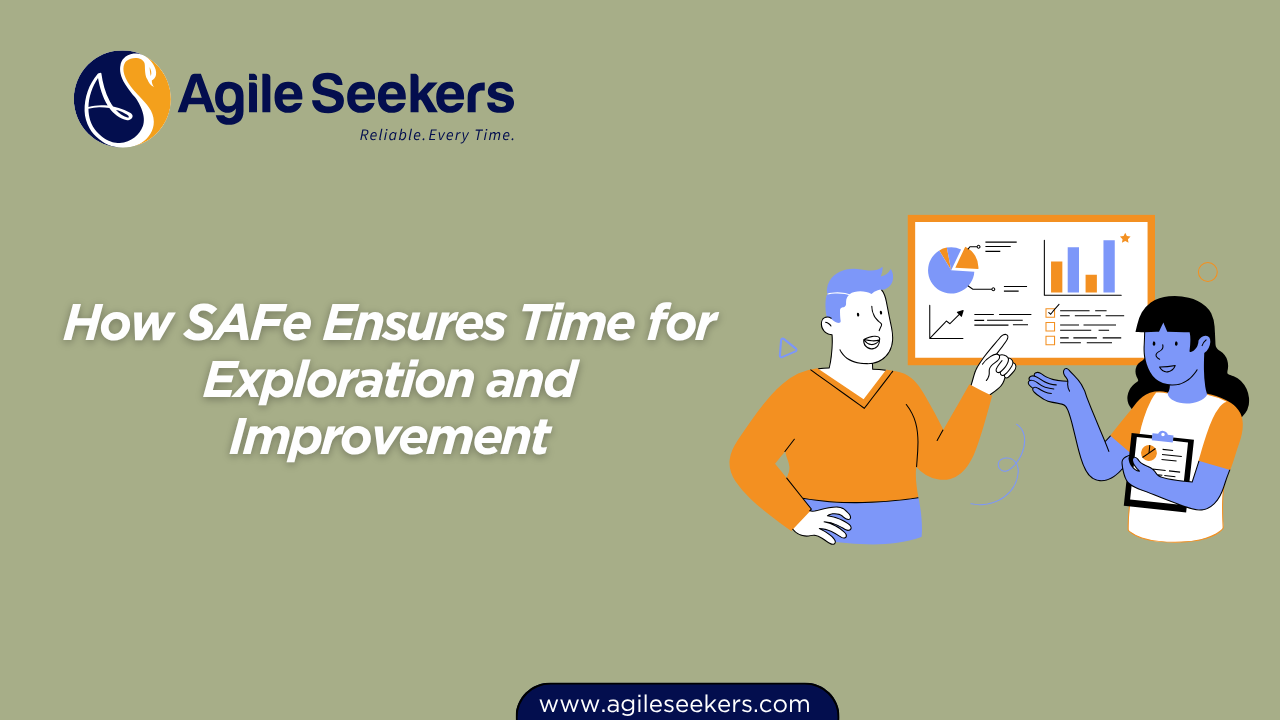How SAFe Ensures Time for Exploration and Improvement

One of the major challenges Agile teams face in enterprise environments is the constant pressure to deliver features, often at the cost of innovation, exploration, and continuous improvement. The Scaled Agile Framework (SAFe) addresses this head-on by deliberately embedding time for innovation, learning, and system-level retrospection into the cadence of the Agile Release Train (ART). This isn’t a bonus or luxury—it’s a necessity for building resilient, adaptive organizations.
Let’s explore how SAFe makes this possible.
1. The Role of the Innovation and Planning (IP) Iteration
The most explicit mechanism SAFe uses to support exploration and improvement is the Innovation and Planning (IP) Iteration, which occurs at the end of every Program Increment (PI). Rather than being treated as optional or buffer time, the IP iteration is a formal, scheduled event with multiple objectives:
-
Allowing time for innovation and hackathons
-
Planning the next PI
-
Conducting the Inspect and Adapt (I&A) event
-
Enabling learning and certification activities
-
Technical debt reduction
By design, this iteration provides space to step back from the delivery treadmill and focus on improving the system as a whole.
Teams are encouraged to experiment with new technologies, refine practices, and improve the architecture—without the immediate pressure of a sprint backlog.
🡆 For a deeper understanding of how to lead large-scale Agile implementations that embrace such practices, consider the Leading SAFe Certification.
2. Built-In Learning Milestones
SAFe encourages learning not only at the team level but also across ARTs and Solution Trains. This happens through several learning-enabling constructs:
-
System Demos: Provide an opportunity for integrated feedback and learning.
-
Architectural Runway Reviews: Ensure space to explore upcoming enabler work.
-
PO Sync and ART Sync: Regular alignment that creates transparency and highlights areas requiring exploration.
Moreover, roles like Product Owners and Product Managers are expected to continuously explore customer needs and market shifts, rather than just manage backlogs. This means reserving time for market research, customer interviews, and prototyping—which are central to the SAFe POPM Certification.
3. Inspect and Adapt (I&A): Structured Improvement Built into the Framework
The I&A event is a cornerstone of continuous improvement in SAFe. It happens during the IP iteration and includes:
-
PI System Demo
-
Quantitative and qualitative measurement review
-
Problem-solving workshop
This event is not just about metrics; it’s about identifying systemic issues, conducting root cause analysis, and putting in place improvement action items. Importantly, leaders attend and commit to these actions.
The inclusion of I&A reflects SAFe's Lean-Agile leadership principle: Base milestones on objective evaluation of working systems, a core idea reinforced in the SAFe Scrum Master Certification.
4. Enablers and Exploration Work in the Backlog
SAFe makes exploration part of everyday work by incorporating Enabler Epics, Enabler Features, and Enabler Stories directly into the team and program backlogs. These include spikes, architectural exploration, UX research, and prototyping.
Unlike traditional frameworks where such work might be neglected or hidden, SAFe recognizes this as first-class work—visible, estimated, and prioritized with clear acceptance criteria.
Scrum Masters and RTEs play a key role in protecting time for this work, guiding teams and ARTs toward a balanced backlog that includes capacity for exploration. These facilitation skills are core topics in the SAFe Advanced Scrum Master Certification.
5. Guarding Agile Team Capacity for Improvement
SAFe encourages teams to explicitly reserve capacity in their iterations for improvement items—technical debt cleanup, automation, tooling enhancements, or better Definition of Done compliance.
For instance:
-
Team can allocate 10-15% of each sprint’s capacity to improvement work
-
Retrospective action items are tracked in the backlog
-
Leaders support time-boxed improvement sprints if necessary
This culture is reinforced when Release Train Engineers actively create space for teams to reflect and innovate, a responsibility covered in the SAFe Release Train Engineer Certification.
6. Decentralized Decision-Making and Local Innovation
Time for exploration doesn’t just depend on scheduled events. It also relies on empowered teams. SAFe promotes decentralized decision-making, allowing teams and ARTs to explore localized solutions without waiting for top-down direction.
This empowerment, supported by Lean budgeting and agile governance, reduces delays and fosters innovation at every level.
External resources like the Scaled Agile Framework article on Decentralized Decision-Making expand on how this principle enables faster learning loops.
7. Metrics That Drive Learning, Not Just Output
SAFe uses a mix of flow metrics, outcome metrics, and predictability measures that shine a light on how well the system is improving. For instance:
| Metric | What It Shows |
|---|---|
| Flow Load | Whether the system is overloaded |
| Flow Time | Time taken from idea to delivery |
| Innovation Accounting | How many enablers or improvement stories were done |
| Team and ART Predictability | Alignment between planned vs delivered work |
These metrics are reviewed in ART syncs and I&A events—not to penalize teams, but to uncover areas needing exploration or structural change.
8. Cultural Support Through Lean-Agile Leadership
Finally, SAFe emphasizes leaders as coaches—those who foster a learning organization. Exploration and improvement aren’t sustainable if the leadership mindset is rigid or delivery-obsessed.
Leaders trained in Lean and systems thinking are more likely to support innovation days, skip-level feedback loops, and budgetary flexibility for R&D. Building this culture is a key outcome of the Leading SAFe Certification.
Final Thoughts
SAFe doesn’t leave time for exploration and improvement to chance. Through the IP iteration, I&A workshops, enabler work, empowered teams, and leadership development, it institutionalizes learning as a core part of delivery—not a distraction from it.
Organizations that take full advantage of these built-in structures are better prepared to adapt, innovate, and continuously grow their system's performance over time.
To gain the practical knowledge and role-specific tools to help your organization explore and improve at scale, explore certifications like SAFe Product Owner/Product Manager (POPM), SAFe Scrum Master, or SAFe Release Train Engineer.
Also read - Scaling Product Ownership in ARTs: Collaboration Across Backlogs




















